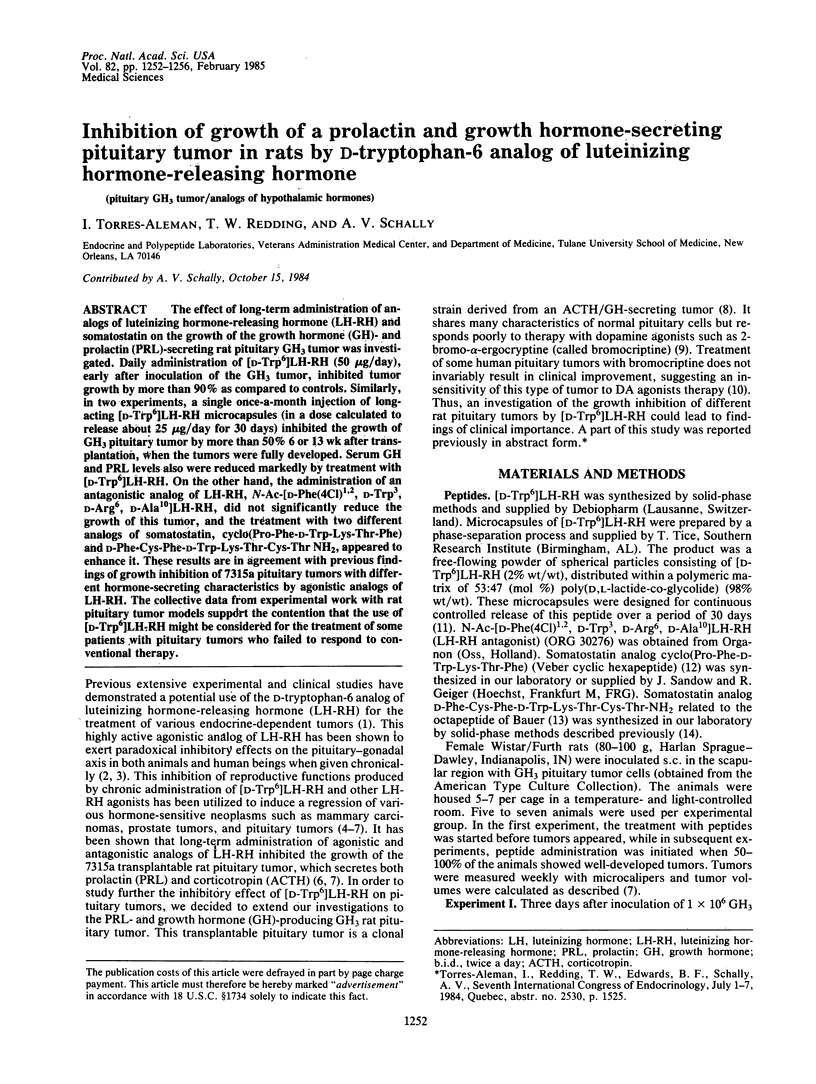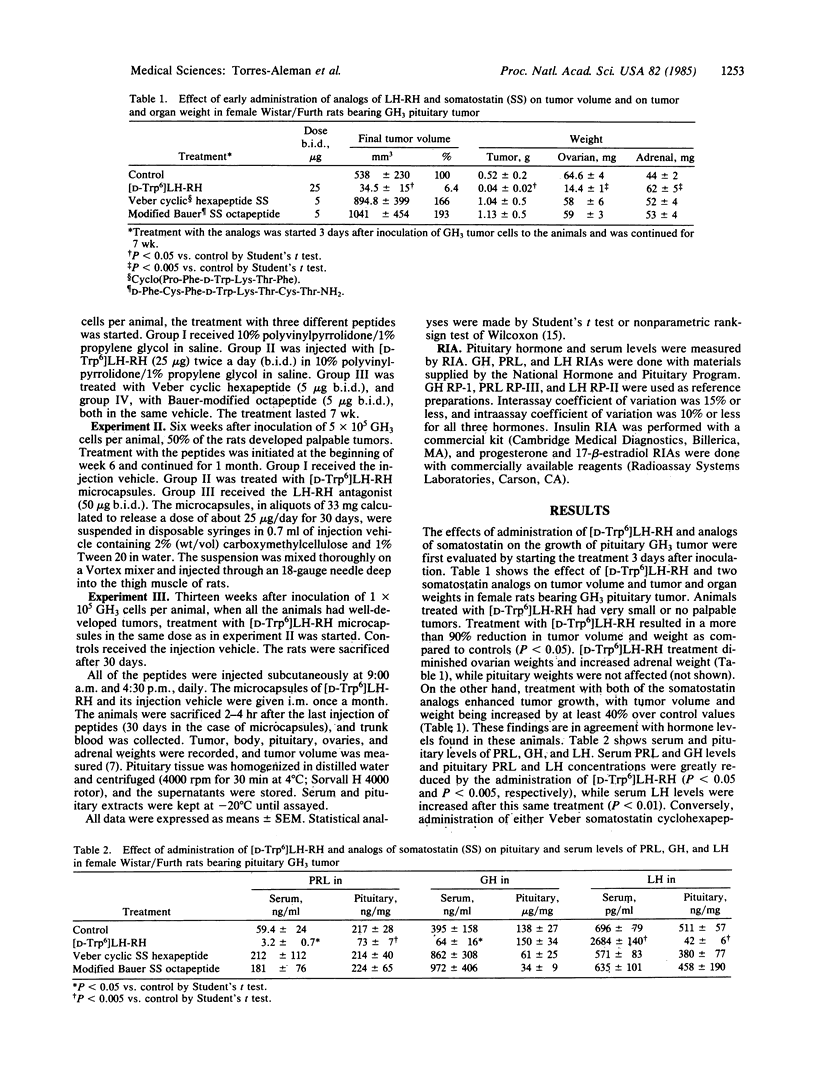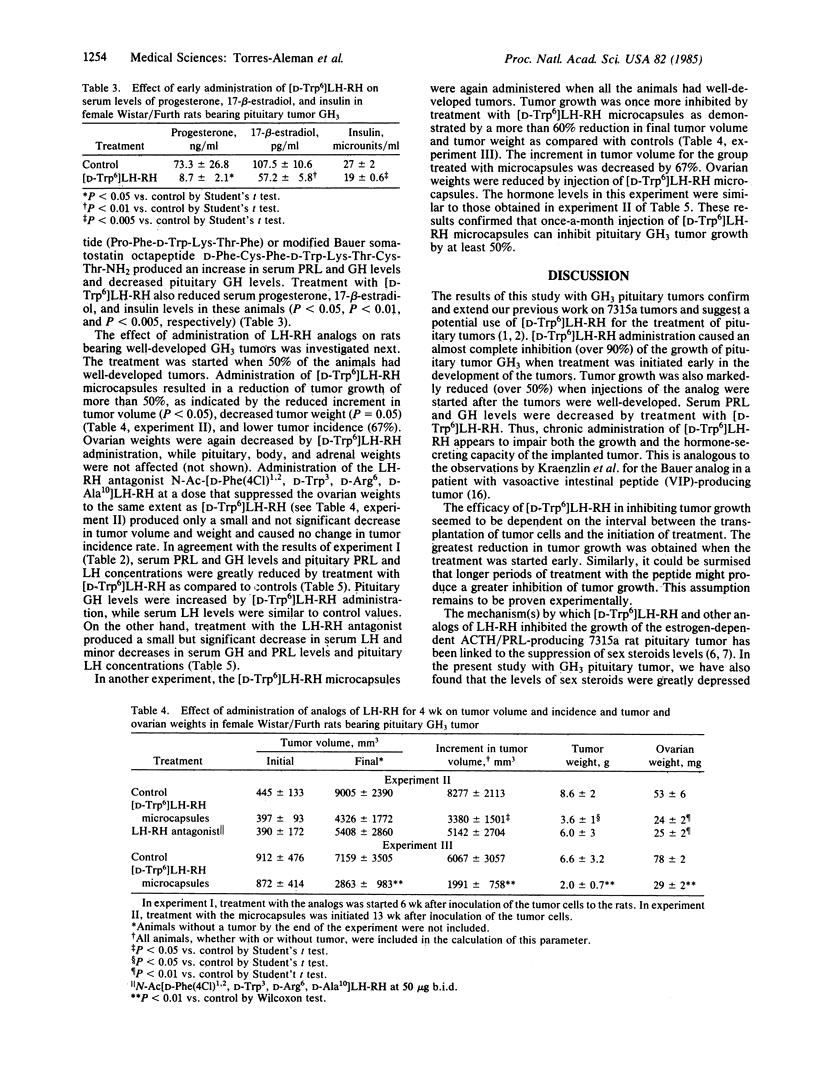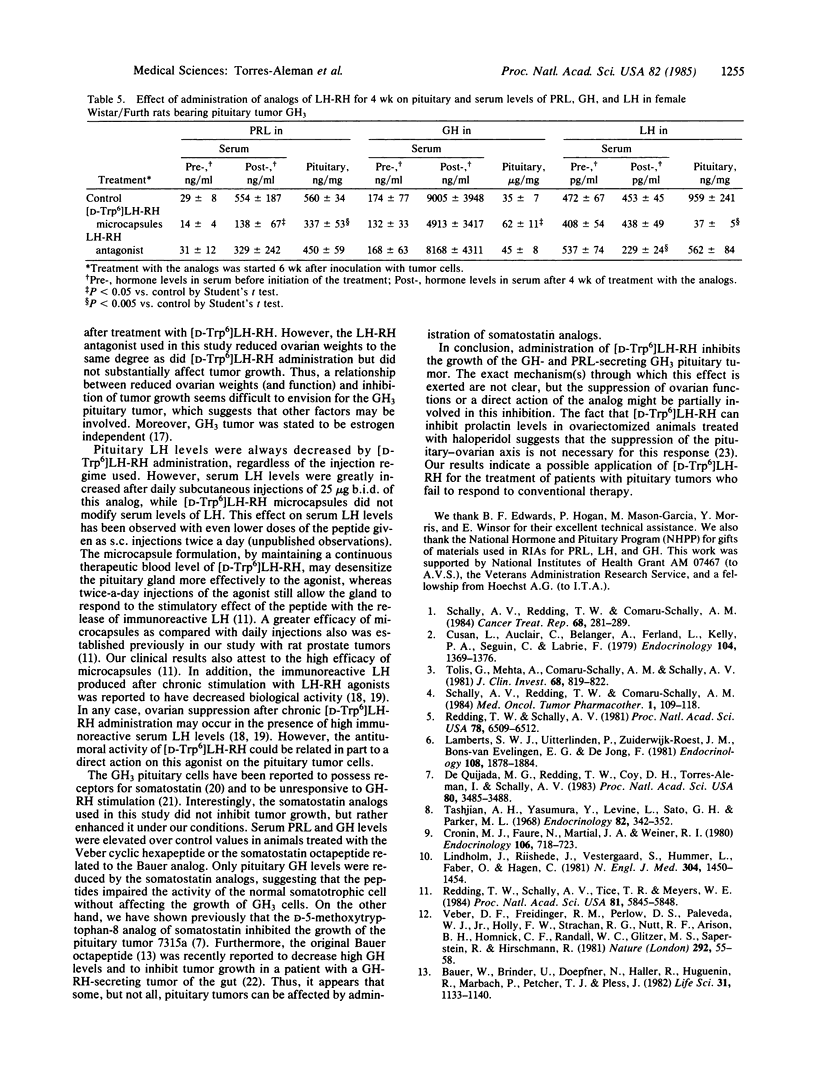Abstract
The effect of long-term administration of analogs of luteinizing hormone-releasing hormone (LH-RH) and somatostatin on the growth of the growth hormone (GH)- and prolactin (PRL)-secreting rat pituitary GH3 tumor was investigated. Daily administration of [D-Trp6]LH-RH (50 micrograms/day), early after inoculation of the GH3 tumor, inhibited tumor growth by more than 90% as compared to controls. Similarly, in two experiments, a single once-a-month injection of long-acting [D-Trp6]LH-RH microcapsules (in a dose calculated to release about 25 micrograms/day for 30 days) inhibited the growth of GH3 pituitary tumor by more than 50% 6 or 13 wk after transplantation, when the tumors were fully developed. Serum GH and PRL levels also were reduced markedly by treatment with [D-Trp6]LH-RH. On the other hand, the administration of an antagonistic analog of LH-RH, N-Ac-[D-Phe(4Cl)1,2, D-Trp3, D-Arg6, D-Ala10]LH-RH, did not significantly reduce the growth of this tumor, and the treatment with two different analogs of somatostatin, cyclo(Pro-Phe-D-Trp-Lys-Thr-Phe) and D-Phe-Cys-Phe-D-Trp-Lys-Thr-Cys-Thr NH2, appeared to enhance it. These results are in agreement with previous findings of growth inhibition of 7315a pituitary tumors with different hormone-secreting characteristics by agonistic analogs of LH-RH. The collective data from experimental work with rat pituitary tumor models support the contention that the use of [D-Trp6]LH-RH might be considered for the treatment of some patients with pituitary tumors who failed to respond to conventional therapy.
Full text
PDF




Selected References
These references are in PubMed. This may not be the complete list of references from this article.
- Bauer W., Briner U., Doepfner W., Haller R., Huguenin R., Marbach P., Petcher T. J., Pless SMS 201-995: a very potent and selective octapeptide analogue of somatostatin with prolonged action. Life Sci. 1982 Sep 13;31(11):1133–1140. doi: 10.1016/0024-3205(82)90087-x. [DOI] [PubMed] [Google Scholar]
- Cronin M. J., Faure N., Martial J. A., Weiner R. I. Absence of high affinity dopamine receptor in GH3 cells: a prolactin-secreting clone resistant to the inhibitory action of dopamine. Endocrinology. 1980 Mar;106(3):718–723. doi: 10.1210/endo-106-3-718. [DOI] [PubMed] [Google Scholar]
- Cusan L., Auclair C., Belanger A., Ferland L., Kelly P. A., Seguin C., Labrie F. Inhibitory effects of long term treatment with a luteinizing hormone-releasing hormone agonist on the pituitary-gonadal axis in male and female rats. Endocrinology. 1979 May;104(5):1369–1376. doi: 10.1210/endo-104-5-1369. [DOI] [PubMed] [Google Scholar]
- Dannies P. S., Yen P. M., Tashijian A. H., Jr Anti-estrogenic compounds increase prolactin and growth hormone synthesis in clonal strains of rat pituitary cells. Endocrinology. 1977 Oct;101(4):1151–1156. doi: 10.1210/endo-101-4-1151. [DOI] [PubMed] [Google Scholar]
- Evans R. M., Doelle G. C., Lindner J., Bradley V., Rabin D. A luteinizing hormone-releasing hormone agonist decreases biological activity and modifies chromatographic behavior of luteinizing hormone in man. J Clin Invest. 1984 Jan;73(1):262–266. doi: 10.1172/JCI111200. [DOI] [PMC free article] [PubMed] [Google Scholar]
- Kraenzlin M. E., Ch'ng J. C., Wood S. M., Bloom S. R. Can inhibition of hormone secretion be associated with endocrine tumour shrinkage? Lancet. 1983 Dec 24;2(8365-66):1501–1501. doi: 10.1016/s0140-6736(83)90847-4. [DOI] [PubMed] [Google Scholar]
- Lamberts S. W., Uitterlinden P., Zuiderwijk-Roest J. M., Bons-van Evelingen E. G., de Jong F. H. Effects of a luteinizing hormone-releasing hormone analog and tamoxifen on the growth of an estrogen-induced prolactin-secreting rat pituitary tumor and its influence on pituitary gonadotropins. Endocrinology. 1981 May;108(5):1878–1884. doi: 10.1210/endo-108-5-1878. [DOI] [PubMed] [Google Scholar]
- Lindholm J., Riishede J., Vestergaard S., Hummer L., Faber O., Hagen C. No effect of bromocriptine in acromegaly: a controlled trial. N Engl J Med. 1981 Jun 11;304(24):1450–1454. doi: 10.1056/NEJM198106113042402. [DOI] [PubMed] [Google Scholar]
- Meldrum D. R., Tsao Z., Monroe S. E., Braunstein G. D., Sladek J., Lu J. K., Vale W., Rivier J., Judd H. L., Chang R. J. Stimulation of LH fragments with reduced bioactivity following GnRH agonist administration in women. J Clin Endocrinol Metab. 1984 Apr;58(4):755–757. doi: 10.1210/jcem-58-4-755. [DOI] [PubMed] [Google Scholar]
- Meyers C. A., Coy D. H., Huang W. Y., Schally A. V., Redding T. W. Highly active position eight analogues of somatostatin and separation of peptide diastereomers by partition chromatography. Biochemistry. 1978 Jun 13;17(12):2326–2331. doi: 10.1021/bi00605a011. [DOI] [PubMed] [Google Scholar]
- Redding T. W., Schally A. V. Inhibition of prostate tumor growth in two rat models by chronic administration of D-Trp6 analogue of luteinizing hormone-releasing hormone. Proc Natl Acad Sci U S A. 1981 Oct;78(10):6509–6512. doi: 10.1073/pnas.78.10.6509. [DOI] [PMC free article] [PubMed] [Google Scholar]
- Redding T. W., Schally A. V., Tice T. R., Meyers W. E. Long-acting delivery systems for peptides: inhibition of rat prostate tumors by controlled release of [D-Trp6]luteinizing hormone-releasing hormone from injectable microcapsules. Proc Natl Acad Sci U S A. 1984 Sep;81(18):5845–5848. doi: 10.1073/pnas.81.18.5845. [DOI] [PMC free article] [PubMed] [Google Scholar]
- Schally A. V., Redding T. W., Comaru-Schally A. M. Inhibition of the growth of some hormone dependent tumors by D-Trp6-LH-RH. Med Oncol Tumor Pharmacother. 1984;1(2):109–118. doi: 10.1007/BF02934982. [DOI] [PubMed] [Google Scholar]
- Schally A. V., Redding T. W., Comaru-Schally A. M. Potential use of analogs of luteinizing hormone-releasing hormones in the treatment of hormone-sensitive neoplasms. Cancer Treat Rep. 1984 Jan;68(1):281–289. [PubMed] [Google Scholar]
- Tashjian A. H., Jr Clonal strains of hormone-producing pituitary cells. Methods Enzymol. 1979;58:527–535. doi: 10.1016/s0076-6879(79)58167-1. [DOI] [PubMed] [Google Scholar]
- Tashjian A. H., Jr, Yasumura Y., Levine L., Sato G. H., Parker M. L. Establishment of clonal strains of rat pituitary tumor cells that secrete growth hormone. Endocrinology. 1968 Feb;82(2):342–352. doi: 10.1210/endo-82-2-342. [DOI] [PubMed] [Google Scholar]
- Tolis G., Mehta A., Comaru-Schally A. M., Schally A. V. Suppression of androgen production by D-tryptophan-6-luteinizing hormone-releasing hormone in man. J Clin Invest. 1981 Sep;68(3):819–822. doi: 10.1172/JCI110320. [DOI] [PMC free article] [PubMed] [Google Scholar]
- Veber D. F., Freidlinger R. M., Perlow D. S., Paleveda W. J., Jr, Holly F. W., Strachan R. G., Nutt R. F., Arison B. H., Homnick C., Randall W. C. A potent cyclic hexapeptide analogue of somatostatin. Nature. 1981 Jul 2;292(5818):55–58. doi: 10.1038/292055a0. [DOI] [PubMed] [Google Scholar]
- Zeytin F. N., Gick G. G., Brazeau P., Ling N., McLaughlin M., Bancroft C. Growth hormone (GH)-releasing factor does not regulate GH release or GH mRNA levels in GH3 cells. Endocrinology. 1984 Jun;114(6):2054–2059. doi: 10.1210/endo-114-6-2054. [DOI] [PubMed] [Google Scholar]
- de Quijada M. G., Redding T. W., Coy D. H., Torres-Aleman I., Schally A. V. Inhibition of growth of a prolactin-secreting pituitary tumor in rats by analogs of luteinizing hormone-releasing hormone and somatostatin. Proc Natl Acad Sci U S A. 1983 Jun;80(11):3485–3488. doi: 10.1073/pnas.80.11.3485. [DOI] [PMC free article] [PubMed] [Google Scholar]
- von Werder K., Losa M., Müller O. A., Schweiberer L., Fahlbusch R., Del Pozo E. Treatment of metastasising GRF-producing tumour with a long-acting somatostatin analogue. Lancet. 1984 Aug 4;2(8397):282–283. doi: 10.1016/s0140-6736(84)90320-9. [DOI] [PubMed] [Google Scholar]


